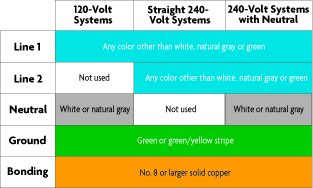Updated January 2017. A healthy dose of intuition and some analytical ability often go a long way in electrical troubleshooting. Quiz customers as to the specifics of the problem:
• What exactly happened to the spa?
• When was the problem discovered?
• Has the spa ever worked properly?
Be a detective. Delve into details. If customers cite a problem with water temperature, ask if it’s too hot or not hot enough. Exactly how hot is the water getting? Does the heater run constantly or intermittently?
The answers can help you determine if electrical woes have caused the problem.
The eyes have it
At the job site, begin by putting safety first and cutting off power to the spa. Locate the main electrical distribution panel or sub panel and switch off the circuit breakers feeding the spa equipment — or remove the fuses. Then, using a voltmeter or multimeter, confirm that the lines are dead.
Now begin a visual inspection of the system. Open the equipment doors and observe. This should take 3 or 4 minutes but may be the most important part of the call.
First, look at the product’s overall condition. Just stand there and look at it. Is everything intact? Has lightning struck? Has someone tampered with it? Maybe there is a burned wire or other type of degradation.
Next, look inside the spa pack. You still have no need to touch anything. While examining the components, keep your customer’s complaint in mind. If it was about a lack of bubbles, look at the blower. Is it corroded? Has a pipe broken? Look over the heater, pump, control panel and so forth.
If you finish the visual inspection with no telltale signs of the problem, investigate the possibility of an electrical problem. For this, you’ll need to turn the power back on.
It’s on? Check the ground-fault circuit interrupters for proper operation. You will find GFCIs located at the house control panel, subpanel, or on the spa itself. Simply press the test button. (Remember, GFCIs may not always protect a technician from across-the-line shocks. Avoid coming in contact with the hot line and the neutral at the same time in a 120-volt system, or touching Line 1 and Line 2 in a 240-volt system. Doing so will not create a fault to ground for the GFCIs to sense and shut down the system.)
If you run across an older spa that does not have a GFCI in place, advise your customers of the current code requirements, as well as the safety benefits of this device.
The pyramid approach
If you have eliminated the spa’s components as the source of the problem and confirmed that the GFCIs are functioning, verify that the power actually comes into the home and arrives at the spa components at the proper voltage levels.
First, techs should ensure that it has the proper voltage, experts say. You have to make sure you’re getting the voltage you require or there will be problems everywhere.
To check for proper voltage, first hook the voltmeter up to the input terminal block of the component in question. This reading will tell you if power reaches the unit. Now go back to the home’s main control panel and read the voltage there with the spa equipment running, so you get a number against which to compare the first reading. The component terminal reading should be only slightly lower than the one at the house. Note: You can only do this test with the load running; there will be no voltage drop if the equipment isn’t running.
Voltage drops come about because wire and every connection add resistance. The longer the wire and the more connections in an electrical service, the greater the resistance. Voltage drop between the input voltage and the voltage at the spa should never exceed 5 percent for any wiring run. If it does, it’s a problem. Three percent is ideal.
Several things can cause voltage drops: a defective breassker, a loose fuse, a burned wire at a terminal, an underground wire chopped or sliced by a shovel, or another appliance sharing the same line as the spa.
The spa should have a dedicated line, according to the experts. If something else is on the line at the same time, such as the air conditioning, it can cause a voltage drop.
To test for the lack of a dedicated line, switch off the spa’s breaker and see which other appliances turn off as well. Of course, if the air conditioning unit shares the line, you may not notice unless it’s summer.
So, how do you check for a dedicated line? It’s not always easy. The wiring to the other appliance is frequently inside the house and not readily visible. Examine the wires connecting the circuit breakers to the spa equipment. That could reveal a problem. Some thorough snooping is in order.
Note: You probably will have discovered any other causes of voltage drop, such as burned wires or a defective breaker panel, during your visual inspection.
Now you know
If a component is to blame, you now must diagnose theat piece of equipment and decide if it needs to be repaired or replaced.



